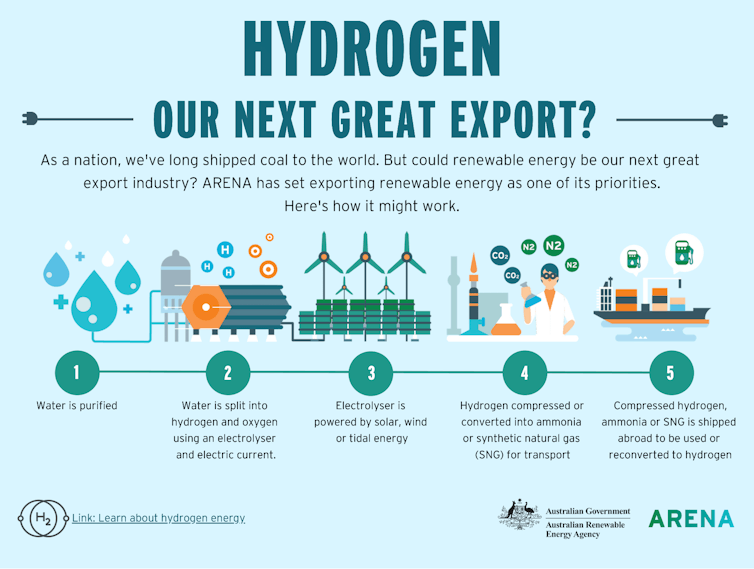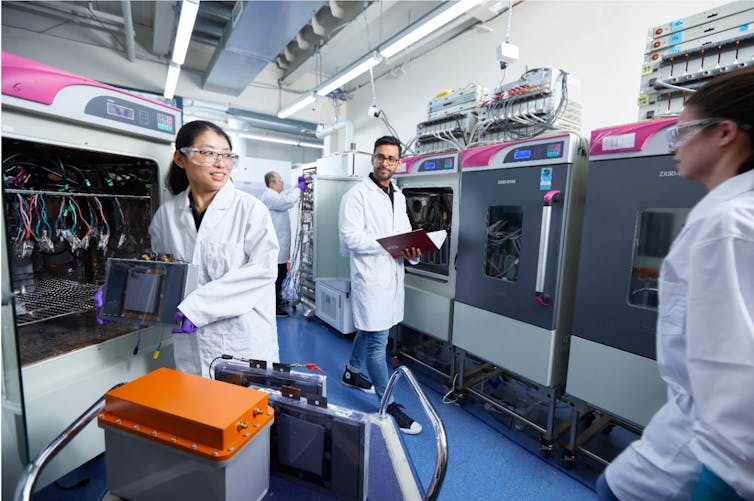Source: The Conversation (Au and NZ) – By Kim Rasmussen, Deputy Dean and Associate Dean, Research, Faculty of Engineering, University of Sydney

Australian Centre for Field Robotics/University of Sydney
Australia has been slow to join the global shift towards decarbonisation and lower emissions. Now, ready or not, the world is on the verge of a climate action crescendo. Australia can choose what to do next: act meaningfully and with determination; dither and have its hand forced; or, at worst, face punishing measures such as tariffs.
Despite our lumbering start, we are in a fortunate position. We do not need to start from scratch to green our economy and participate wholly in the decarbonisation revolution. While Australia debates “where to from here” as world leaders come together for COP26 in Glasgow, university researchers have long been heads down developing the very research, talent and technology we’ll need for this transformation.
Read more:
Scott Morrison is hiding behind future technologies, when we should just deploy what already exists
With the right mix of industry and government support, these university-developed resources will allow us to pivot to a decarbonised economy. Australia can emerge as a green export and research and development leader.
Across engineering and science, we’re witnessing a research and technology explosion. The once unimaginable is being made possible. We are seeing advances in many fields, including:
-
renewable and low-emission technologies
-
energy generation, utilisation and storage
-
electrification and network hybridisation
-
power fuels, including hydrogen.
With our abundant natural and mineral resources and agricultural industry, these are all areas in which Australia can and should lead to become a research and development exporter. Aside from helping to transition our economy and lower emissions, this would attract further overseas talent and investment.
Australia has an untapped opportunity to switch from being an exporter of carbon fuels to an exporter of green fuels. We can do this by converting solar and wind energy to stored energy like hydrogen. For domestic consumption, there is a wider range of energy-storage options including batteries and Snowy 2.0.

ARENA, CC BY
Federal support for developing a green fuel export industry is growing slowly. However, industry and financial consortia have been investing rapidly in green technologies and plants.
Scale of challenge demands collaboration
Tackling climate change requires a collective approach. That’s because it affects every sector and part of society.
Universities were once considered somewhat siloed. Now they are working more closely with other institutions. Formerly disparate areas of expertise are being connected to develop research and technology to tackle and adapt to climate change.
Examples of collaboration range from historians and engineers working together to better understand how climate change led to the demise of Angkor through to using data analytics to better understand the impacts of the resource sector on the environment. Increased collaboration between disciplines and institutes makes universities an attractive resource and “one-stop shop” for companies looking to decarbonise or expand their offerings to compete in the green economy.
Read more:
How universities and professions are preparing to meet the climate challenge
Campuses too are being transformed into high-impact, industrial research hubs. They are gearing up for greater industry collaboration, testing and rapid prototyping.
These campus facilities include state-of-the-art infrastructure, ranging from nano technology and foundries to advanced manufacturing and microanalysis. They are helping to develop scalable and translatable research for both large existing companies and start-ups.
Research is already paying off
Universities are also increasingly commercialising their research and technology. In the process, they are developing companies with the potential to rewrite Australia’s climate change fate.
One such company is agri-robotics start-up Agerris. It’s commercialising technology developed over the past 15 years from the University of Sydney’s Australian Centre for Field Robotics, a source of several successful start-ups. Agerris’s robotics solutions to optimise farming have the potential to control emissions in agriculture and related areas including forestation and oceanography.
Another example is zinc-bromide battery developer Gelion. This spin-off from the University of Sydney Nano Institute is disrupting the solar energy industry with its safe, cost-effective products.

Gelion/University of Sydney
Snowy Mountains Hydro, while one of the most ambitious feats of engineering ever achieved, should not remain our nation’s industrial magnum opus. It’s vital Australia embarks on an ambitious plan to lower emissions and decarbonise our economy. If we want the next big thing, we can bet universities are already developing the thinking and technology behind it.
Read more:
Climate change is the most important mission for universities of the 21st century
All academics know that often the best students are the ones who work diligently and consistently over a long period. Others may wait until the last minute, with some bright, creative minds somehow always pulling through with distinction.
We are now at the 11th hour. Let’s hope Australia is that precocious student who can pull it all off in the nick of time.
![]()
The authors do not work for, consult, own shares in or receive funding from any company or organisation that would benefit from this article, and have disclosed no relevant affiliations beyond their academic appointment.
– ref. How can Australia get cracking on emissions? The know-how we need is in our universities – https://theconversation.com/how-can-australia-get-cracking-on-emissions-the-know-how-we-need-is-in-our-universities-170374







